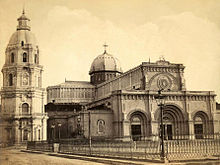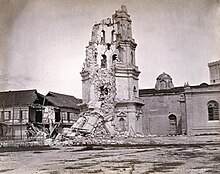Manila Cathedral
The Cathedral of Manila (" Manila Metropolitan Cathedral-Basilica " or " Cathedral-Basilica of the Immaculate Conception ") is one of the four Basilicae minores and the seat of the Archdiocese of Manila in the capital of the Philippines Manila . It stands in the central square in the Spanish city fortress Intramuros opposite the entrance to the Fuerza de Santiago . A few hundred yards away stands the church of San Agustin , which since 1993 along with the Baroque churches in Santa Maria , Paoay and Miag-ao in the World Heritage List of UNESCO stands.
The house of God dedicated to the Immaculate Conception of Mary is the ninth church building on this square.
history
The first church was founded in 1571 by Juan de Vivero , who as early as 1566 reached Maynilad, then under the rule of Rajah Sulayman and his relative Rajah Matanda, as a chaplain in the entourage of the conquistador Miguel López de Legazpi on the galleon San Geronimo . After Legazpi had defeated the two rulers in the battle of May 19, 1571, he founded the city of Manila and the first church was built in the typical wooden construction of the time. In 1574 the victory over the Chinese pirate Lin Feng was celebrated here .
The first cathedral - also made of wood - was built in 1581 as a result of the founding of the Diocese of Manila and by Pope Gregory XIII. consecrated. The first Synod of Manila was held here in 1582. In 1583 the cathedral fell victim to the great fire in Manila. It was rebuilt in the same construction, which was criticized by the Junta Universal de Manila in 1586 . On June 15, 1588, the cathedral was the victim of a typhoon that destroyed much of Manila. When Gomez Perez Dasmariñas became the new governor of the Philippines in 1590, the decision was made to build a stone cathedral.
The construction of the first completely made of stone erected church building in the Philippines lasted from 1590 to 1597. It was the first complete with bells, holy relics etc. equipped church in Southeast Asia . In 1595 Pope Clement VIII made Manila the seat of the Archdiocese of Manila, which he established . In 1599 the cathedral, which was damaged by another earthquake, was repaired. She also fell victim to the great earthquake in Manila on December 31, 1600. As early as July 6, 1601, Governor General Francisco Tello informed the Spanish king that the church, including the bell tower and sacristy, had been successfully renovated. In fact, the restoration took considerably longer due to lack of funds.
The actual restoration actually corresponded to a new building that was only initiated by Archbishop Benavides in 1603 and lasted eleven years. In 1614 the building, consisting of a main nave and two side aisles, was inaugurated. Ten altars and seven chapels were integrated. The new building was financed by Don Francisco Gomez de Arellano, the treasury of the archdiocese and the Spanish royal family. On August 1, 1621, the cathedral was badly damaged in an earthquake, the roof partially collapsed and cracks formed in the masonry. The church building could, however, be saved and restored. The cathedral was renovated between 1641 and 1645, but was completely destroyed in an earthquake on November 30, 1645.
Reconstruction only began on April 20, 1654 when Archbishop Poblete laid the foundation stone. The new building progressed rapidly until 1659, so that the first mass was held on December 7, 1659. However, the expansion lasted until 1662, when the cathedral was completed in its basic structure and the consecration took place on June 7th. The cathedral with the main nave and two side aisles was approx. 67 meters long, approx. 25 meters wide and approx. 15 meters high. Seven pillars were positioned on each side of the main nave. The entrance to the main portal had a total of three doors. The church had two prayer rooms for Spaniards and three for Filipinos. The interior construction dragged on until 1681, Archbishop Camacho invested a total of 40,000 pesos in the interior design. Between 1736 and 1740 the cathedral was renovated under the direction of Archbishop Rodriguez.
In 1747 Pedro de la Santisima became Archbishop of Trinidad. As a scientifically trained man of the Enlightenment, he saw the need to completely restore or redesign the cathedral in order to arm it against earthquakes, typhoons and fires. The Jesuit and architect Joaquin Mezquita and the military engineers Don Tomas de Castro y Andrade and Don Antonio Gonzalez de Quijano then examined the cathedral and prepared an expert report on the condition and the possibilities of converting the building. In 1751 the renovation began by the Italian architect Juan de Uguccioni and the Peruvian Don Estevan Roxas y Melo. The renovation dragged on until 1760 and it got its appearance, which was retained until 1852. It was consecrated by the Bishop of Cebu , as Archbishop Trinidad had died in 1755.
From 1762 to 1764 the British temporarily occupied parts of the Philippine archipelago and the capital Manila as part of the Seven Years' War . The cathedral was badly damaged in the British invasion of the Philippines in 1762 , and many precious relics and art treasures were destroyed or stolen by the British. The recently appointed Archbishop Rosa had to buy himself out for 31,309 Pesos. After the British left, the building was repaired and given a new interior, but this took several years to complete. Until 1852 the cathedral was renovated several times. On the night of September 16, 1852, Manila was struck by a severe earthquake that destroyed large parts of the city. During an inspection by the architects de Hacienda, Juan Mendoza y Grajales, the building was classified as totally destroyed and irreversible.
The then governor of the Philippines, General Antonio de Urbiztondo, commissioned a team of engineers to rebuild the sixth cathedral. The work, under the direction of Nicolas Valdes, dragged on for six years, with parts of the old building being used and integrated. The church was consecrated on March 31, 1858, but was only to last for five years. On the evening of June 3, 1863, Manila was struck by a severe earthquake, in which the cathedral was completely destroyed again, except for the bell tower. Many people were killed in the collapse as a mass was being held at the time of the quake. This is how the diocesan administrator Pedro Pelaez died . He is considered the father of the secularization movement in the Catholic Church in the Philippines. The historically best-known priests who worked at Manila Cathedral during this period include Jose Burgos and Jacinto Zamora , who together with Mariano Gómez went down in the history of the Philippines as the Gomburza Trio .
A reconstruction was initially refrained from until May 12, 1868, the architect Vicente Serrano y Salaverri was commissioned to investigate the condition of the ruins. According to his report of July 31, 1868, the ruins had to be demolished and removed before a new building was built. On April 13, 1870, the governor issued a directive to remove the heap of rubble. On June 15, 1870, the Junta Consultativa para los Restauraciones de las Yglesia was founded to support the new building. The actual work began after December 13, 1873 and continued until 1879. In some cases, the work was delayed by the activities of trade unions and the newly emerging participation movements that would later lead to the national movement of Katipunan and the Philippine Revolution .
In 1880 another earthquake destroyed the old bell tower and replaced it with a temporary wooden structure . The cathedral served as a refuge for Spanish soldiers during the Spanish-American War and as a hospital for wounded American soldiers during the Filipino-American War . From this point on, the monopoly of the Roman Catholic Church in the Philippines began to waver, and the first missionaries of the Protestants and Anglicans set foot in the Philippines.
Since then, Catholicism has changed in the Philippines and has increasingly taken on independent features. The Manila Cathedral did not remain untouched, so more and more local artists were commissioned to conserve or redesign the interior. Up until the Second World War , there was a lot of activity among artists around the Manila Cathedral. During the Second World War, the cathedral provided protection for resistance fighters against the Japanese occupation from 1942 to 1945. In 1945, the cathedral was completely destroyed by the bombing of Manila by the US Air Force in the Battle of Luzon .
The cathedral was rebuilt until 1958, after the major destruction of the Second World War in Manila was cleared. The architecture of the new cathedral was based on the pre-war cathedral and was rebuilt in the historicist architectural style of the 19th century. The highlights were the visits of Popes Paul VI. , in November 1970, and John Paul II , in February 1981.
See also
Other major churches in the Philippines
- Basílica de San Sebastián in Manila
- Basilica of the Black Nazarene
- Basilica of St. Lorenzo Ruiz
- Basilica of Our Lady of Peñafrancia
- Menor ng San Miguel Arkanghel Basilica
- Basilica ni San Martin ng Tours
- Santo Domingo Church
gallery
Web links
Coordinates: 14 ° 35 ′ 29.3 ″ N , 120 ° 58 ′ 24.8 ″ E










